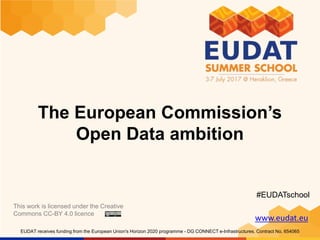
The European Commission's Open Data ambition (Marjan Grootveld) - EUDAT Summer School | www.eudat.eu
- 1. www.eudat.eu EUDAT receives funding from the European Union's Horizon 2020 programme - DG CONNECT e-Infrastructures. Contract No. 654065 The European Commission’s Open Data ambition This work is licensed under the Creative Commons CC-BY 4.0 licence #EUDATschool
- 3. European Commission’s ambition EC in the Guidelines: “This template is not intended as a strict technical implementation of the FAIR principles, it is rather inspired by FAIR as a general concept (…) without suggesting any specific technology, standard, or implementation solution” 3 http://ec.europa.eu/research/participants/data/ref/h2020/grants_manual/hi/oa_pilot/h2020-hi-oa-data-mgt_en.pdf EC Infographic: http://ec.europa.eu/research/images/infographics/policy/open-data-2016-w920.png
- 4. Data Management in Horizon 2020 Deposit the data underlying your scientific publications, including the metadata, documentation and tools needed to validate the results, in a research data repository – for sharing and preserving the data long-term. Sharing more data is encouraged. Write, and keep up-to-date, a Data Management Plan. Regular project deliverable, due by Month 6 Living document Template with guidelines available Make data “as open as possible, as closed as necessary”: opting out – fully or in part – is possible, but needs justification. Manage and document all data FAIRly, whether they will be open or not. 4
- 5. Guidelines on FAIR DM v.3 Structure of the Guidelines: 1. Background: extension of the pilot 2. DMP general definition 3. Proposal, submission and evaluation 4. RDM plans during the project life cycle 5. Support 6. Annex 1: the DMP template 1. Data summary 2. FAIR data 3. Allocation of resources 4. Data security 5. Ethical aspects 6. Other issues 7. Summary table “Fair DM at a glance” 5 http://ec.europa.eu/research/participants/data/ref/h2020/grants_manual/hi/oa_pilot/h2020-hi-oa-data-mgt_en.pdf
- 7. Exercise Section 2.3 of the DMP template concerns interoperability. Apply both questions in section 2.3 to your own domain (or the domain that you support). Describe the relevant standards for data and metadata. Describe what is needed or possible to allow interdisciplinary interoperability. Reflection and discussion with your neighbour: should you change your way of working? Should others? You have 45 minutes before wrap-up.
- 9. Our suggestion Metadata: Data Documentation Initiative (DDI), which is standard in social sciences http://rd-alliance.github.io/metadata-directory/standards/ File formats Movies: .mp4 – MPEG-4 H.264 Texts: .pdf or .txt – PDF/A and Unicode, resp. Spreadsheets: .csv Things to do: Agree on the metadata fields Agree on folder structure and file-naming convention Start documenting
- 10. www.eudat.eu Authors: Marjan Grootveld, DANS Sarah Jones, DCC This work is licensed under the Creative Commons CC-BY 4.0 licence
Editor's Notes
- This presentation will give an introduction to the Open Research Data Pilot in H2020.
- EC Infographic: http://ec.europa.eu/research/images/infographics/policy/open-data-2016-w920.png
- The EC in the H2020 programm has adopted the FAIR principles. It is important to realise that these are PRINCIPLES: it is up to you to plan and describe what in means in practice for your project, within your research discipline. Also, your data should be open by default: you should share them with others beyond your project consortium, unless you justify why this is not possible.
- More formally, these are the requirements of the Open Research Data Pilot: At least the data on which your publications are based must be deposited at a repository, along with the context documentation. When you are not allowed to archive a tool or specific software, you can deposit a description of it. Of course you can also make other data, not underpinning a paper, available to others. Should be described in the DMP. Complementary to the project plan you should plan how to manage the data during and after the project. The DMP is s regular project deliverable, due by M6. The EC, like many other funders, regard it as a living document, which you should keep up to date. For instance, when at some point during the project you realise that part of the data cannot be shared openly, you must submit an updated DMP in which you explain this. Not really different from other official plans, is it? And opt out does not affect the evaluation of the project: neither at the proposal stage, nor during the project, will you be punished for opting out. Of course you must still be FAIR.
- Here is the content of the EC’s Guidelines. They explain what is expected of projects and what should be addressed in the DMP. For the next exercise we have copies of the DMP template which we will use during the summer school. So please keep it!
- A lot of what we do in daily life is about interoperability. In some domains ”I” may look like something new, but it isn’t, as you can see from the examples: Time, Distance, Musical Pitch and more recently medical classification are all based on standards, consensus, common reference points. In the same way that different fields have their own metadata, they can have their own standards and procedures to achieve interoperabilty of data sources, and these should be mentioned in the DMP.
- [hand out the template]
